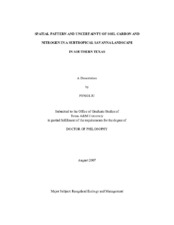| dc.contributor.advisor | Boutton, Thomas W. | |
| dc.contributor.advisor | Wu, X. Ben | |
| dc.creator | Liu, Feng | |
| dc.date.accessioned | 2010-01-15T00:00:21Z | |
| dc.date.accessioned | 2010-01-16T01:58:58Z | |
| dc.date.available | 2010-01-15T00:00:21Z | |
| dc.date.available | 2010-01-16T01:58:58Z | |
| dc.date.created | 2007-08 | |
| dc.date.issued | 2009-05-15 | |
| dc.identifier.uri | https://hdl.handle.net/1969.1/ETD-TAMU-1609 | |
| dc.description.abstract | Woody invasion into grasslands has been reported world-wide and has affected both the magnitude and spatial heterogeneity of soil carbon (C) and nitrogen (N). Since grasslands cover a large portion of the Earth's land surface, invasion of woody plants could have impacts on regional and global biogeochemistry. To understand large-scale ecological and policy implications of woody invasion, it is critical to understand the spatial pattern and uncertainty of soil C and N and their relationship with vegetation and soil attributes, as well as develop effective approaches to estimate soil C and N over large landscapes and regions. The goal of this study was to improve our understanding of the spatial pattern of soil organic carbon (SOC) and total nitrogen (TN) and their controlling factors in savanna landscapes and develop efficient sampling strategies for evaluating the effects of woody invasion. Specific objectives of this study were to: (1) Quantify the spatial pattern and uncertainty associated with SOC and develop efficient sampling strategies to estimate SOC storage; (2) Assess the influence of soil and vegetation factors on spatial distribution of SOC and TN; and (3) Determine the influence of physical variables related to landscape position and soil on woody vegetation structure. Conditional sequential indicator simulations indicated that woody encroachment into grassland increased both spatial heterogeneity and uncertainty of SOC, which increased errors in estimating SOC storage. Stratified random sampling with higher density in woody patches, plus structured sampling in cluster with strong spatial pattern, substantially increased estimation accuracy. Efficient sampling strategies for estimating SOC storage were developed based on these findings. Direct and spatial correlation and scaling analyses showed that SOC and TN were strongly correlated with litter and root biomass. Invaded woody vegetation has the most impact on spatial distribution of SOC and TN. Canonical correspondence analysis showed that variables related to landscape position were the primary factors determining the spatial distribution of woody species. These new insights will facilitate the estimation of soil C and N pools at landscape and regional scales, and will help evaluate the potential impacts of woody plant encroachment on the biogeochemistry of C and N. | en |
| dc.format.medium | electronic | en |
| dc.format.mimetype | application/pdf | |
| dc.language.iso | en_US | |
| dc.subject | Spatial pattern | en |
| dc.subject | Spatial uncertainty | en |
| dc.subject | Woody invasion | en |
| dc.subject | Soil organic carbon | en |
| dc.subject | Total nitrogen | en |
| dc.subject | Sampling design | en |
| dc.subject | Prosopis Glandulosa | en |
| dc.subject | Sequential indicator simulation | en |
| dc.subject | Canonical correspondence analysis | en |
| dc.subject | domains of scale | en |
| dc.subject | geostatistics | en |
| dc.title | Spatial pattern and uncertainty of soil carbon and nitrogen in a subtropical savanna landscape in southern Texas | en |
| dc.type | Book | en |
| dc.type | Thesis | en |
| thesis.degree.department | Rangeland Ecology and Management | en |
| thesis.degree.discipline | Rangeland Ecology and Management | en |
| thesis.degree.grantor | Texas A&M University | en |
| thesis.degree.name | Doctor of Philosophy | en |
| thesis.degree.level | Doctoral | en |
| dc.contributor.committeeMember | Hallmark, C. Thomas | |
| dc.contributor.committeeMember | Smeins, Fred E. | |
| dc.type.genre | Electronic Dissertation | en |
| dc.type.material | text | en |
| dc.format.digitalOrigin | born digital | en |


